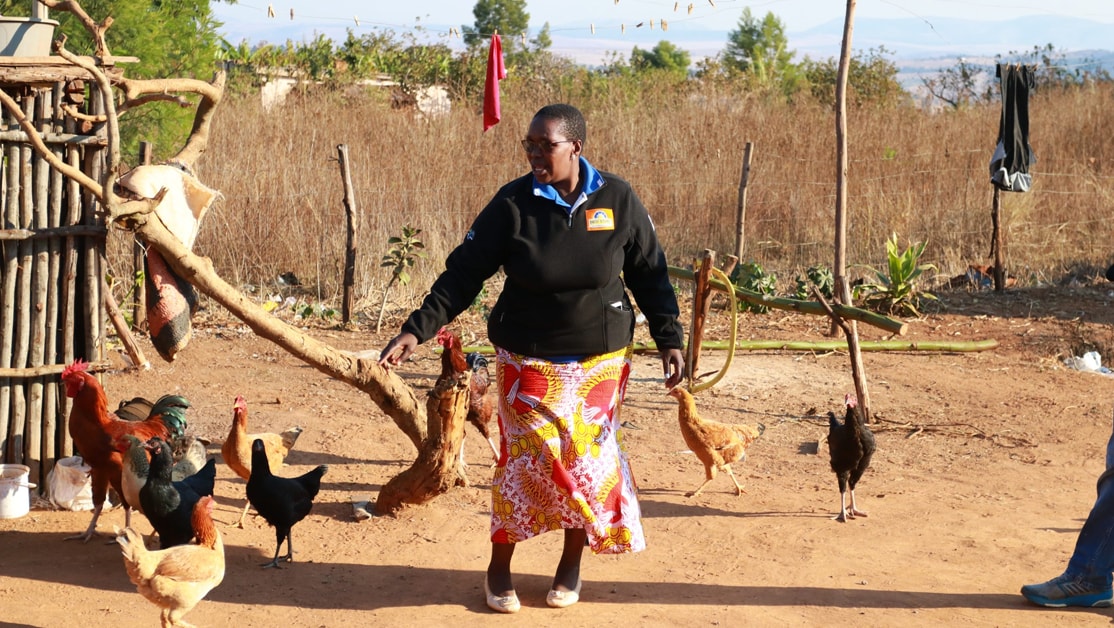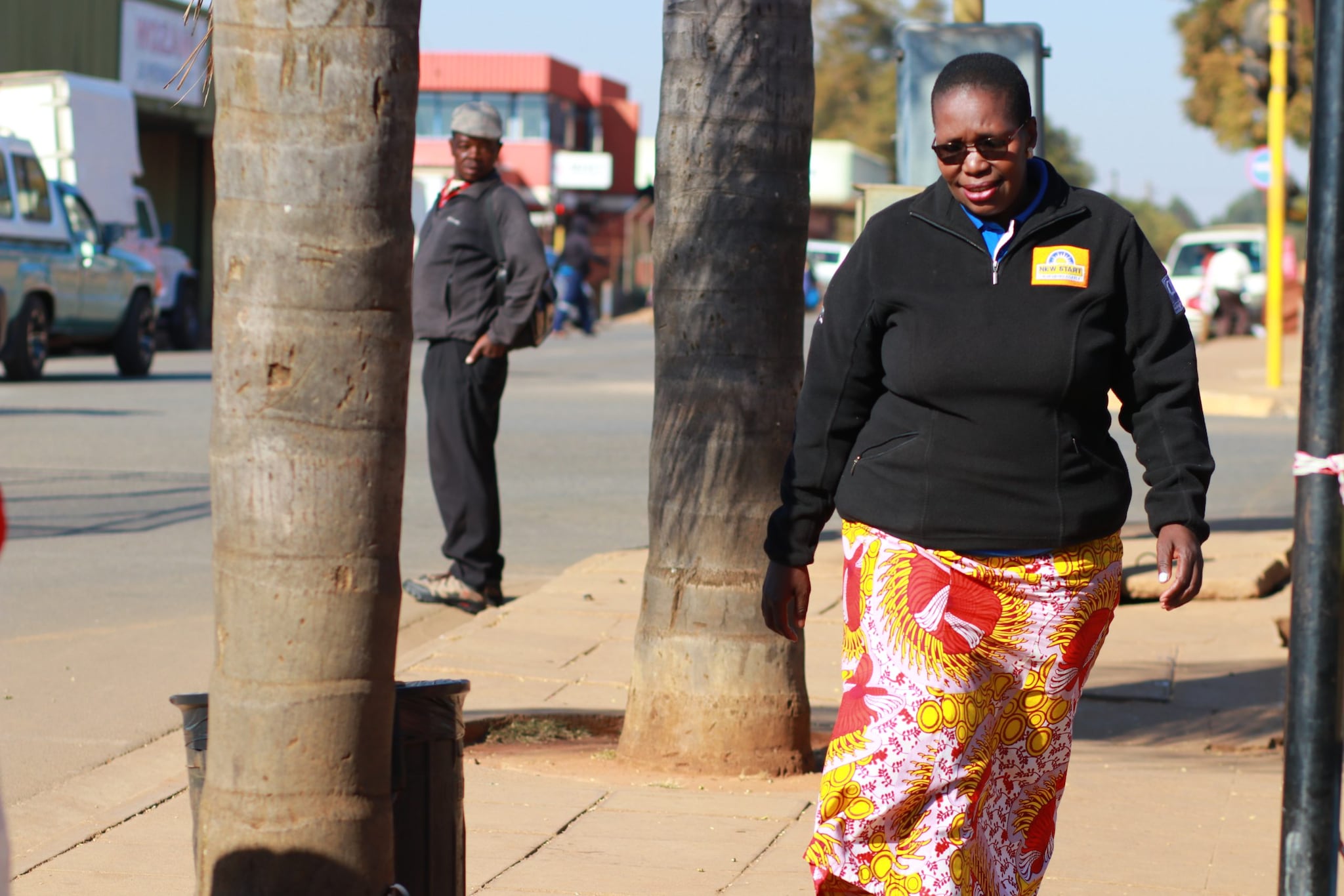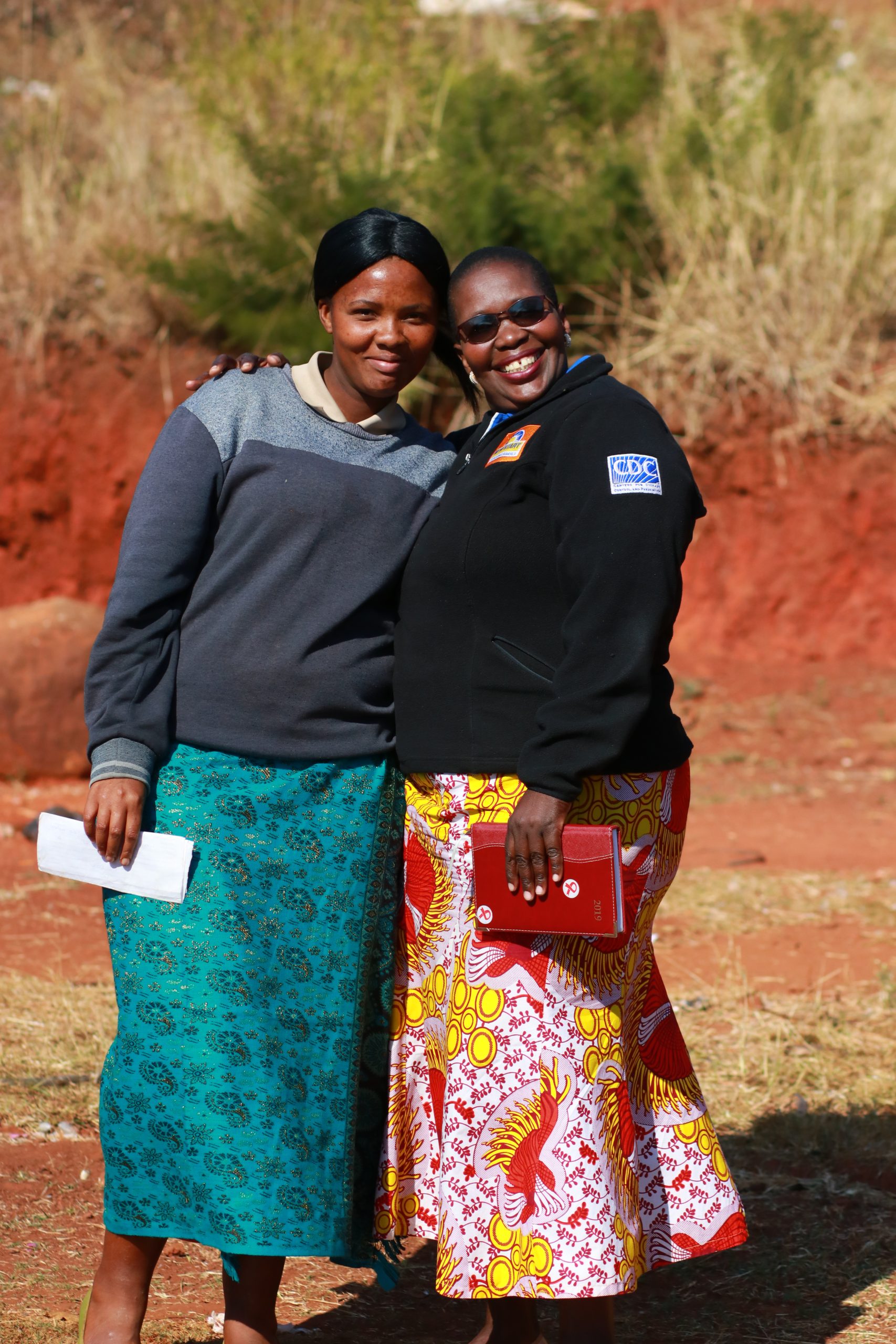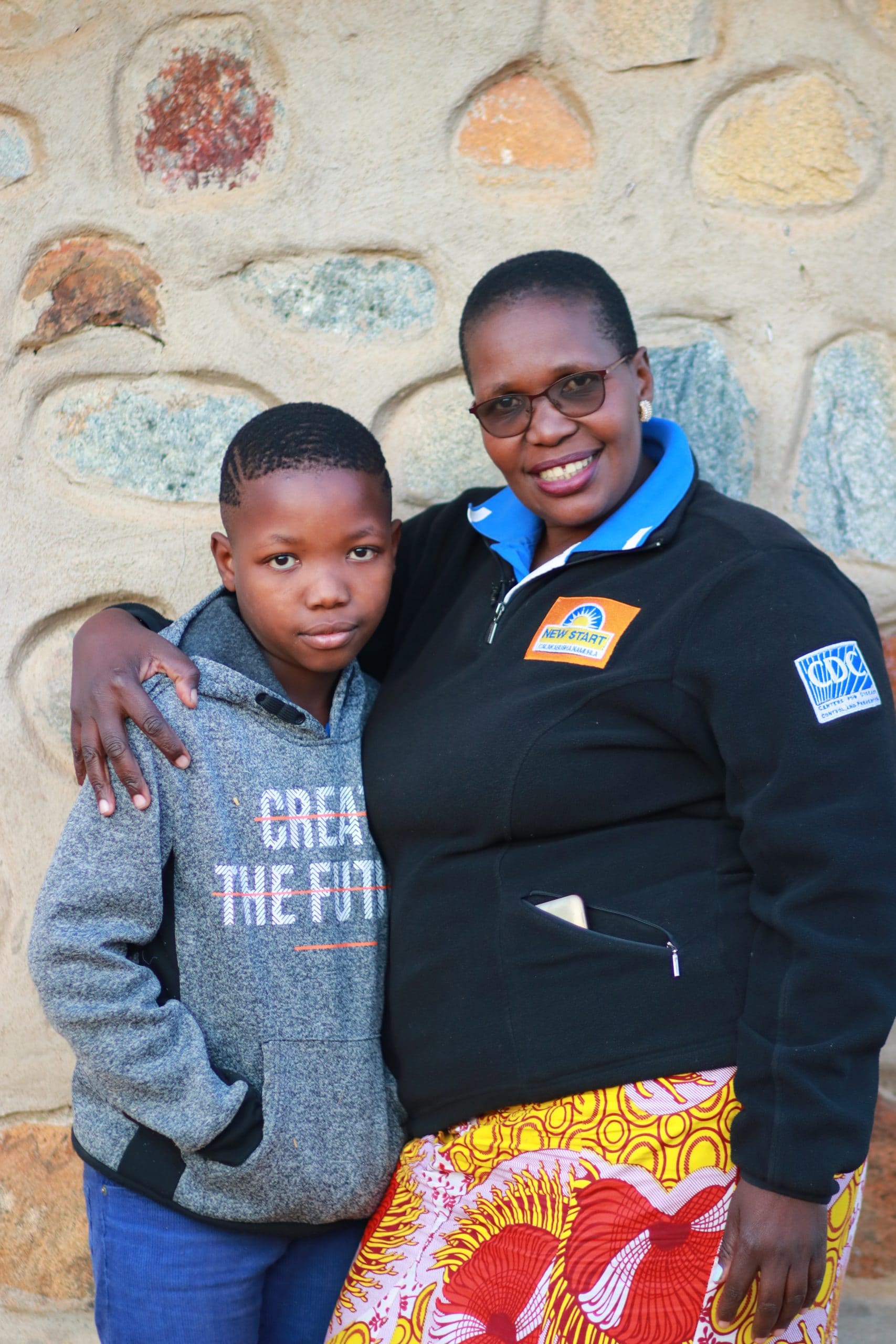At a glance
Thembi, an HIV advocate, lives in a rural area of Eswatini. In 1999, before treatment was widely available, she was diagnosed with HIV. Now, she is healthy, with no detectable virus in her body and is the mother of two boys, both of whom are HIV-free. Today, Thembi serves as an expert in her community helping others navigate HIV.
Thembi's Story

Brittany Moore 2019
On an early Tuesday morning in 1999, Thembi made the 20-mile trip from her home nestled in the rural hills of the tiny kingdom of Eswatini to the nearest health clinic to get tested for HIV. Her husband had exhibited symptoms of the disease, and she was afraid she may have contracted the potentially deadly virus.
She spoke with the nurse about her risk, she sat through counseling, she even provided a sample, but she was afraid of what came next. So afraid, in fact, that she didn't wait for the nurse to return with the results. Her fear was understandable. These were the early, dark days of HIV in Eswatini. A time where stigma and fear around the disease prevailed – even more so than it does today. Few people had access to treatment and a positive diagnosis was almost certainly a death sentence.
Once back at home, Thembi only became sicker. She began exhibiting symptoms of the virus. Then she contracted tuberculosis (TB) – a ravaging disease that often attacks those with HIV because of their weakened immune systems. In fact, TB is the number one killer of those living with HIV. Shortly after this, she developed pneumonia and became so ill she was bedridden for more than a year and a half. Then, she lapsed into a coma.
Her family, her doctors, they all believed she would never recover. But after two weeks, miraculously, she woke up from the coma, and learned the hard news: she was, indeed HIV positive. By this time, she was determined to fight.

Brittany Moore 2019
She began HIV antiretroviral treatment—a daily cocktail of three separate drugs – and slowly her health and her strength returned.
Today, more than 20 years since her diagnosis, Thembi is healthy, with no detectable virus in her body. She is also the mother of two boys, both of whom are HIV-free.
Today, she is a powerhouse of a woman, with a contagious laugh and a 100-watt smile who doles out generous hugs to strangers and family alike. She often marvels at her own transformation and breaks into dance without provocation – as if each moment is a celebration of life.
Not only is she thriving but she also now serves as an expert in her community—helping others deal with this potentially deadly virus—and serving as a model in her community on how to beat HIV.
Eswatini's Journey
Thembi's story—as harrowing and courageous as it is—mirrors the very trajectory of the HIV epidemic in the country she calls home.
Just two decades ago, Eswatini, then known as Swaziland, had the highest HIV prevalence in the world and was a country on the brink of destruction. Almost 1 in 3 adults was living with the virus, the death rate was staggering and HIV was destabilizing families, communities and the country's economy.
"Back then, people in Eswatini often had to decide which funeral to go to on any given day," recalls former CDC-Eswatini Country Director, Caroline Ryan M.D., "those were very dark days."
Then, the Government of Eswatini declared HIV a national emergency. With the support of the U.S. President's Emergency Plan for AIDS Relief (PEPFAR) and CDC, the country engaged in an accelerated, multi-sectoral emergency response to ensure effective HIV treatment and prevention to all citizens who needed it.
"Under the leadership of the King, with the full support of PEPFAR and with CDC's technical expertise on the ground, we were able to launch a comprehensive response that helped transform our approach to this epidemic," says Rejoice Nkambule, Deputy Director of Health Services in the Eswatini Ministry of Health.
"We created awareness, expanded treatment and prevention, strengthened patient support and follow-up and trained our health care workers to better serve and reach those living with and at risk for HIV. Everyone and every sector was engaged to help rebuild our country," she said.

Brittany Moore 2019
In the ensuing years, the country has made dramatic progress. In fact, a 2017 survey showed that in the five years between 2011 and 2016, the country's rate of new HIV infections was cut in half, the national rate of viral suppression doubled and Eswatini became the first country to achieve the UNAIDS definition for HIV epidemic control.
But challenges remain – for people like Thembi living with the disease and for the country as a whole.
In 2018, nearly 8,000 adults in this small, landlocked Southern African country were newly infected with HIV and almost 3,000 people died from an AIDS-related illness – a staggering number considering the population is less than 1.5 million. And despite the prevalence of the disease in the country, stigma remains pervasive.
CommLink, CDC's peer linkage program
On this day, Thembi is providing peer support as an expert client for Thuli* — a 28-year-old woman who has just learned, a few weeks earlier, that she is HIV positive.
She tells a heart-rending story of having recently left her partner who threatened her with bodily harm if she ever became HIV positive. She would later learn that he was, in fact, HIV positive and had transmitted the virus to her. Until she met Thembi at a community event a week earlier, she had been too afraid to start treatment.
But, today, she will travel from her home high in the hills of Eswatini to a clinic more than 50 miles away — to receive treatment, get tested to determine her viral load, and gain the information and care she needs to keep the virus in her body under control.

Brittany Moore 2019
Thembi is with her every step of the way. Picking her up from her home and traveling the far distance to the clinic. She sits beside her as she receives her medication and explains the process. She then accompanies her to the HIV counselor and then next to the lab where her blood is drawn as a benchmark to be able to gauge her treatment progress over time.
It's all part of a CDC program known as CommLink that pairs HIV positive individuals, known as expert clients, with newly diagnosed patients in an effort to encourage them to get and stay on treatment. The expert clients work as a peer support system, helping the new patient navigate the process of clinic visits and treatment protocols. But more than this, they serve as an emotional support for those moments when their determination wavers under the weight of fear and stigma.
Data suggest that without linkage to services, fewer than 1/3 of Eswatinis diagnosed in community settings become enrolled in HIV care within six months of diagnosis, delaying critical HIV treatment. A pilot of the CommLink program launched in Eswatini found that nearly all (98%) of the HIV positive individuals who participated were linked successfully to care, and most (83%) began treatment within days after being linked. A more recent analysis of the program also found that peer counselors play a critical role in helping clients resolve barriers to HIV treatment. Due to its overwhelming success, the program is now being rolled out, more broadly, throughout Eswatini and is being expanded to reach others like Thuli in countries throughout sub-Saharan Africa.
"At first I was lost," Thuli admits, "but when I met Thembi she gave me hope. If it wasn't for her, I would not have started treatment. But seeing how healthy she is, it makes me realize I can live long and be healthy too."
A new day
For Thembi, her return to full health – both physically and mentally – has been a journey of determination and sheer will.
When she first disclosed her HIV status, she was kicked out of her church, scorned by her neighbors and abandoned by her partner. But today, she and her sons have built a new home near the center of this rural community. She appears in newspapers and on the radio touting the importance of HIV testing and treatment and of self-acceptance and is seen as one of the region's foremost HIV advocates.
Today, like the country she calls home, she has risen from the ashes and serves as a beacon of hope for countless others. "Sometimes when I think about my life," she says, "I think God brought me back from the grave so I can tell my story and help save others as well."
Eswatini is one of nine countries globally that has achieved HIV epidemic control thanks to the efforts of CDC and PEPFAR. Additionally, in 2020, Eswatini became one of only two countries to meet the 95-95-95 UN 2030 AIDS treatment target an entire decade in advance: 95% of people living with HIV in Eswatini know their status, 95% of people who know their HIV-positive status are accessing treatment and 95% of people on treatment have suppressed viral load.

Brittany Moore 2019
Over the past 17 years, PEPFAR has helped save more than 18 million lives like Thembi's by providing innovative, data-driven treatment and prevention to those affected by HIV. As a key implementing agency of PEPFAR, CDC plays a critical role – supporting lifesaving treatment for 9.2 million people living with HIV in 2019, more than one third of all people on treatment worldwide.
- *Not her actual name
